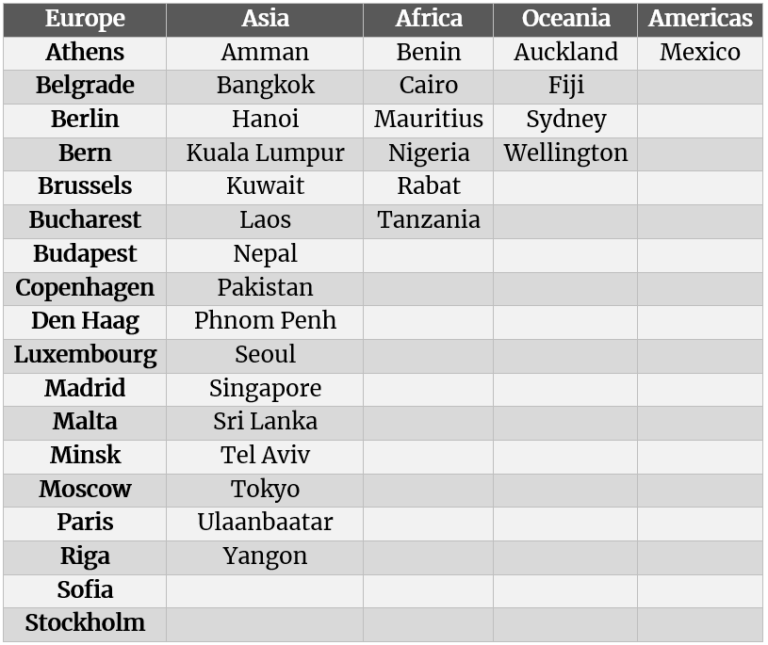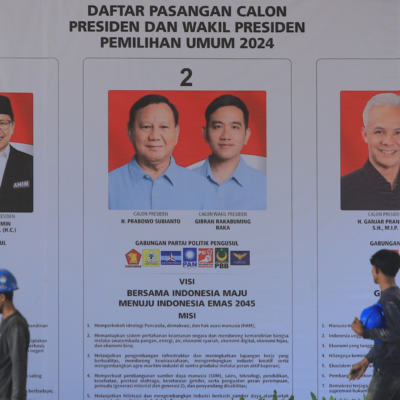China Cultural Centres (CCCs) are organisations established outside China by its Ministry of Culture and Tourism. Initiated in the late 1980s, there are now more than 40 CCCs in a number of countries across Europe, Asia, Africa, Oceania, and the Americas. The number of CCCs has accelerated since the turn of the century, when China began to implement its ‘going out’ (走出去 zou chuqu) strategy (the promotion of Chinese investments abroad) in the cultural realm. The intention to keep increasing the number of CCCs worldwide remains a priority of the Chinese government, with the goal to have established 55 CCCs by 2025.
CCCs have so far attracted little controversy, especially in comparison with Confucius Institutes (CIs)—Chinese language and culture centres set up in foreign universities. Why is this the case, and does this make CCCs a successful example of cultural diplomacy for China?
My research
This article analyses CCCs through the lens of academic discussions on cultural diplomacy and comparisons with other cultural diplomacy initiatives, particularly CIs. It uses data collected from six semi-structured interviews conducted in Australia in 2022 with cultural diplomats, academics, a senior arts administrator and a Chinese Australian artist, as well as policy documents published by the Chinese government, the headquarters of CCCs, and the Chinese media. All respondents included in this research have worked with the CCC in Sydney and attended its cultural events, hence providing valuable insights into CCCs based on their experiences. Five interviews, each lasting 60-80 minutes, were carried out online, with one conducted via email.
This study argues that CCCs’ setup, activities, and locations in the world have thus far helped it evade much criticism. This, however, does not demonstrate its effectiveness as a Chinese cultural diplomacy initiative.
An overview of CCCs
CCCs are at the forefront of China’s cultural diplomacy efforts. Chinese top leaders highly value CCCs, frequently attending their events during diplomatic visits overseas. For example, former Chinese President Hu Jintao was present at the ‘foundation stone laying ceremony’ for the CCC in Berlin in 2005. Former Chinese Premier Wen Jiabao inaugurated the CCC in Bangkok in 2012, and China’s current President Xi Jinping unveiled the CCC in Sydney in 2014.
The purpose of CCCs, as stated on their official website (which is currently unavailable, but a full-size screenshot of the original webpage is available here), is to strengthen cultural exchange and cooperation between China and the host country and to enhance mutual understanding and friendship between peoples from both countries. A former Chinese diplomat in Canberra told me that the purpose of establishing the CCC in Sydney was ‘to promote cultural exchange and cooperation between China and Australia, and to help the Australian public understand China in a positive way and know a true China’. While this view acknowledges an idealistic intention, it also reflects a strategic motivation related to image shaping through China’s cultural diplomacy. This strategic narrative concerning CCCs’ purpose is further manifested in Chinese domestic discussions, not least among Chinese government officials who are in charge of CCCs. For example, Zheng Hao, Deputy Director of the Ministry of Tourism and Culture’s Bureau of International Exchange and Cooperation, which functions as the administering agency of CCCs, says that the Chinese government regards CCCs as a platform to showcase China’s image in the world, and perceives them as a critical part of strengthening China’s international communication capacity and promoting Chinese culture globally. Ding Wei, former Chinese Vice Minister for Culture, states that an essential mission of CCCs is to ‘tell the Chinese story well, spread Chinese voice well, explain Chinese characteristics as well as values and ideas’.
CCCs’ strategic underpinning, together with government-led development, shows its strong affiliation with the Chinese government. While government links to cultural organisations, as scholar Jeffrey Gil notes, are not uncommon (Cervantes Institute, Alliance Française, and the Japan Foundation), cultural diplomacy experts, Jessica Gienow-Hecht and Mark Donfried, have warned that state-driven cultural diplomacy is likely to be perceived to be ‘propaganda’, particularly in relation to China, as explained by Ingrid d’Hooghe.
Confucius Institutes have been accused of being ‘a way for Beijing to spread propaganda under the guise of teaching, interfere with free speech on campuses and even to spy on students’. Compounded by geopolitical factors, concerns regarding CIs’ connection to the Chinese government have further led to the closure of some institutes in North America and Europe, federal investigations into CIs in Australia following the introduction of the Foreign Influence Transparency Scheme, and more recently, the British Prime Minister Rishi Sunak’s call to ban all CIs in the UK.
However, despite their close affiliations with the Chinese government, CCCs have so far caused little controversy and resistance in their host countries. This point has been acknowledged by scholars including Zhang Xiaoling and Guo Zhenzhi as well as Liu Xin, and is also supported by my interviews with diplomats, academics, and professionals in the arts and cultural sphere in Australia. A former Australian diplomat believes that a CCC in particular country are less controversial because of ‘how it has been set up and what it has done’.
The setup of CCCs
Zhao Shaohua, former Chinese Vice Minister for Culture, states that the establishment of CCCs is based on mutual consent between China and the host country at a national government level. As such, typically, only one centre will be set up in a host country, with the exception of New Zealand, where two CCCs have been established in Wellington and Auckland. This largely explains why there are far fewer CCCs than CIs, which are set up through agreements with individual universities rather than national governments. Liu Xin, a scholar of Chinese cultural diplomacy, argues that CIs are more liable to cause controversy as they have a considerably larger presence than CCCs.
From a structural perspective, CCCs are set up as standalone organisations, which are physically independent entities without fixed partners in their host countries. China’s approach to establishing CCCs is similar to that of European cultural institutes such as the Alliance Française, Goethe Institute, and British Council, which, as Chinese public/cultural diplomacy scholar Falk Hartig explains, are created abroad as standalone branches (structurally independent of local collaborators) and coordinated by a governing body in the home country. The structural approach of CCCs appears to be different from that of CIs, which are typically established as ‘joint ventures’ between Chinese and international partner organisations within foreign universities.
The way the CCCs are set up, as one artist involved with the CCC in Sydney argues, is the same as that used by foreign cultural institutes of other countries including the US and Germany, and therefore follows ‘international convention’, making it less controversial. Other interviewees are also of the opinion that CCCs’ structure helps avoid potential controversy. A former Australian diplomat notes that:
The Cultural Centres are much closer and much more similar to other bodies, let us say the Deutsch Institute or the Japan Foundation, [from] other countries, which have cultural centres in Australia. It’s a structure which Australia was already familiar with because it had been done by other countries, so they understood what the Cultural Centre was about.
The same diplomat argues that the CCCs’ structure makes them ‘more transparent, more easily understood’ in comparison to CIs, which the general public tends to feel ‘are hiding behind the walls of the university. And therefore, they don’t understand quite what they are about or how they are operating’.
An academic interviewee agrees, stating that as CIs are established within universities, they could be perceived by some as an organisation designed to ‘infiltrate Australian educational institutions… whereas the Cultural Centre doesn’t infiltrate anyone’.
Activities of CCCs
According to the central website of CCCs, they deliver a range of cultural events including performances, exhibitions, art festivals, talks, cultural and sports contests. They also host courses related to Chinese language and culture as well as sports and exercise and provide information services through their libraries to the public in host countries. At first glance, these activities are not very different from those carried out at CIs, which conduct Chinese language courses and cultural events such as exhibitions, screenings and talks.
However, despite some overlap, scholars have suggested that CCCs’ activities are primarily centred on arts and culture, whereas the CIs’ are mainly focused on language. One senior arts administrator further points out that CCCs are more engaged in ‘presentational, cultural activity, whether it be through music, dance or visual arts’, while ‘Confucius Institutes are primarily academically orientated’. In other words, CCCs’ approach to delivering events is largely through presentation of arts and cultural programs, whereas CIs conduct language-based activities through tertiary education in host universities. This has led to concern that CIs allow the Chinese government to gain influence over the study of China and Chinese language in foreign universities, and it could inhibit ‘the candid discussion, inquiry, and research that are essential to university life’ due to university staff’s potential self-censorship on sensitive topics in the eyes of the Chinese government. These concerns have led to calls from the Canadian Association of University Teachers and the American Association of University Professors to terminate CIs in Canada and the US respectively.
The geographical location of CCCs
As shown in the table below, compiled based on information published by the headquarters of China’s overseas cultural and tourist organisations, CCCs are present in five continents. Notably, there are no CCCs in the US, where China’s cultural diplomacy has arguably been the most controversial. This is demonstrated by Gil’s research, which reports that the US has the largest number of closures of CIs to date, having shut down 89 out of 122 institutes in the country.
There is no direct evidence showing that the lack of CCCs in the US is an intentional act of the Chinese government, but it does explain, in part, why CCCs have received little criticism in comparison to CIs.
Table 1: Locations (Country or City) of CCCs

Are CCCs an effective cultural diplomacy initiative?
While some researchers consider CCCs’ lack of criticism as proof of success, Liu challenges such an equation by suggesting that the purpose of cultural diplomacy is not simply about evading controversy.
Cultural diplomacy, as defined by American political scientist Milton Cummings, is ‘the exchange of ideas, information, art, and other aspects of culture among nations and their peoples in order to foster mutual understanding’. Therefore, as scholar Jiagu Richter rightly points out, a country’s cultural diplomacy, though part of the diplomatic strategy of the state, can only be successful when it promotes understanding and dialogue with those in host nations. In this sense, CCCs’ avoidance of controversy is not direct evidence of its efficacy as part of Chinese cultural diplomacy.
The effectiveness of CCCs is dependent on the impact they have on the foreign public. However, a lack of resistance to CCCs from overseas audiences is important to their continued operation and development in the world because the prospects of such cultural endeavours are partly ‘shaped through responses to them’ in host countries, as manifested in the case of CIs. It is in this light that a less critical reaction to CCCs abroad remains valuable to China’s cultural diplomacy, as a way of facilitating engagement and dialogue.
Throughout this article I present Chinese personal names according to the Chinese custom of placing the family name first followed by the given name.
I wish to thank all interviewees for their contribution. I would also like to thank Dr Jeffrey Gil and the anonymous reviewer for their useful suggestions. My thanks also go to Cathy Harper for editing this article.
Image credit: IQRemix/Flickr.




